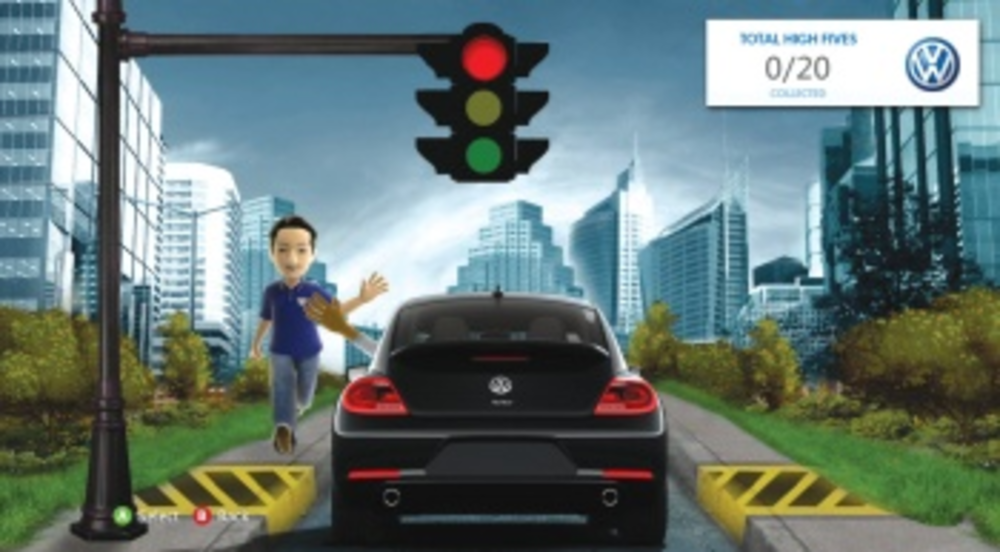Some marketers may balk at the expense of Volkswagen‘s videogame for Microsoft Corp.’s Xbox to support the launch of the 2012 Beetle. However, Volkswagen of America EVP and chief product and marketing officer Tim Mahoney says the game — which mirrors the campaign’s ?TV spots, showing consumers driving around in a Beetle and giving passersby high-fives — “seemed ideally suited to reinforce ?the TV spot.”
That thinking has become more common in automotive marketing. Scott Symonds, general manager at AKQA, says the vertical over-indexes as digitally adventurous because it was early to the medium and reaped high return on investment by experimenting with novel-for-the-time tactics such as ?display ad retargeting.?
Early as auto was to retargeting, it continues to be among the first at bat with more recent digital innovations, even some yet to be released. As part of the Beetle campaign, Volkswagen created a Beetle-themed image for the forthcoming Facebook Timelines profile format. Mahoney says the brand chose to create the profile image as a way to highlight the fact that Volkswagen had changed the shape of the Beetle for the 2012 edition.?
The Beetle campaign wasn’t the only time this year Volkswagen took a nontraditional marketing approach. Before the brand’s Super Bowl commercial “The Force” ever aired, 13.7 million consumers had already seen the spot online after Volkswagen leaked the spot. The marketer monitored Facebook and Twitter to identify buzzwords before purchasing search ads.?
Volkswagen is not the only auto brand to stagger the rollout of a campaign in such a way. Toyota Motor Sales U.S.A.‘s roughly $180 million fall campaign around the 2012 Camry featured print, online and out-of-home, as well as six TV ads — none of which aired until weeks after Toyota had launched the Camry Effect online hub.?
Facebook, out-of-home ads
Consumers who visit the Camry Effect site are asked to answer a series of questions about their cars, such as model year, color and where the consumer drives it. “Then Toyota can take their stories to use as reviews for people currently in market for a Camry,” says Chris Adams, executive creative director at Saatchi & Saatchi LA, which worked with Toyota on the campaign.?
Nissan Motor Co. invests more of its marketing budget in TV than digital because of its reach, but the manufacturer makes sure to extend the investment via digital channels, says Bill Peffer, director of marketing communications at Nissan. ?
Experimentation doesn’t mean a lack of accountability, however. “We’re held to very high standards for every investment we make,” Peffer says. ?
For example, as part of an integrated campaign for the 2012 Versa Sedan, Nissan rolled out an interactive iAd. Asked why Nissan chose to include an expensive ad unit whose reach is limited to owners of Apple mobile devices, Peffer says that in addition to Apple “being able to deliver on certain communication goals we have,” the novelty and easy targetability of the product were also factors. ?
Likewise, Volkswagen will roll out a campaign early next year around the launch of the 2012 Golf R model, but as opposed to a slew of TV spots or social media initiatives, the campaign will center around an iPad app. Mahoney says the app’s features will include contact information for Volkswagen dealers, a car configuration tool and a timeline of past Golf models.?
The Golf R is marketed to “a tightly defined community” of digitally savvy enthusiasts “who like to see pictures, video and know the heritage of [the car],” Mahoney says. “When you think about it, you can’t do that in a 30-second TV spot or in a print ad or exclusively at events. For us, [the iPad app] wraps all of that into one place.”?
All the better for Volkswagen’s number crunchers. Digital is “the CFO’s preferred medium” because of its measurability, Mahoney says. Digital has helped to coalesce marketing strategies and execution between auto brands and their dealerships, he adds. ?
“This industry is much further along in the area of lead generation and lead management,” Mahoney says. “The local Brooks Brothers doesn’t know I’m looking for a new suit unless I walk through the door, but the local Volkswagen dealership probably [knows I’m looking for a new car] because they can either find me muddling around on a competitive site or our site, and then I have a chance to raise my hand and say I configured a car and would like a dealer to get in touch with me. That data can be pushed in real time out to the dealers, and it’s not unrealistic that within a very short period of time you can expect a phone call.”?
In early October, the New Mexico-based Ford dealership Rich Ford began tagging models on its lot with quick response (QR) codes, which consumers could scan via mobile devices to receive information about the vehicles. After scanning the codes, consumers were asked whether they were interested in taking a test drive. FordDirect, a joint marketing program between Ford Motor Co. and dealers, alerts dealers about prospective customers.?
“People are going to scan that QR code, leave, and then see what they have going on with their car without any salesperson helping them at that point,” says Della Andersen, customer relations director at Rich Ford. “But we’re going to have that lead and as soon as [the consumers] say they want to talk to somebody about the lead, we can call them or text them and let them know what we have available.”







